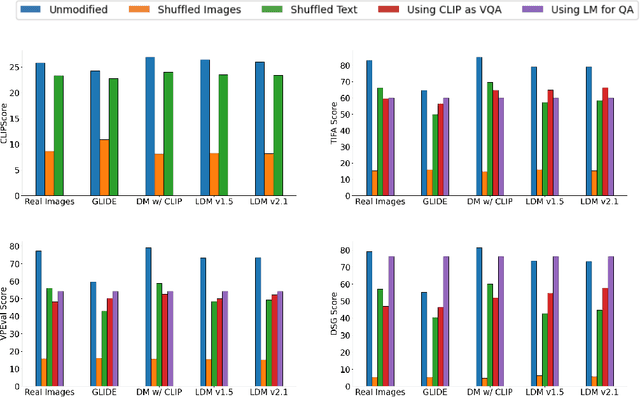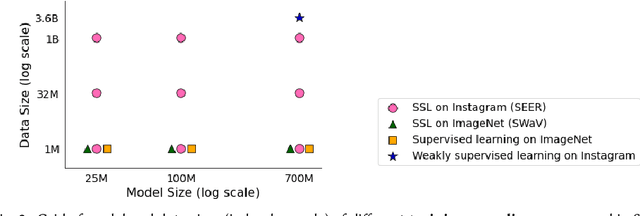Adriana Romero Soriano
What makes a good metric? Evaluating automatic metrics for text-to-image consistency
Dec 18, 2024



Abstract:Language models are increasingly being incorporated as components in larger AI systems for various purposes, from prompt optimization to automatic evaluation. In this work, we analyze the construct validity of four recent, commonly used methods for measuring text-to-image consistency - CLIPScore, TIFA, VPEval, and DSG - which rely on language models and/or VQA models as components. We define construct validity for text-image consistency metrics as a set of desiderata that text-image consistency metrics should have, and find that no tested metric satisfies all of them. We find that metrics lack sufficient sensitivity to language and visual properties. Next, we find that TIFA, VPEval and DSG contribute novel information above and beyond CLIPScore, but also that they correlate highly with each other. We also ablate different aspects of the text-image consistency metrics and find that not all model components are strictly necessary, also a symptom of insufficient sensitivity to visual information. Finally, we show that all three VQA-based metrics likely rely on familiar text shortcuts (such as yes-bias in QA) that call their aptitude as quantitative evaluations of model performance into question.
Consistency-diversity-realism Pareto fronts of conditional image generative models
Jun 14, 2024



Abstract:Building world models that accurately and comprehensively represent the real world is the utmost aspiration for conditional image generative models as it would enable their use as world simulators. For these models to be successful world models, they should not only excel at image quality and prompt-image consistency but also ensure high representation diversity. However, current research in generative models mostly focuses on creative applications that are predominantly concerned with human preferences of image quality and aesthetics. We note that generative models have inference time mechanisms - or knobs - that allow the control of generation consistency, quality, and diversity. In this paper, we use state-of-the-art text-to-image and image-and-text-to-image models and their knobs to draw consistency-diversity-realism Pareto fronts that provide a holistic view on consistency-diversity-realism multi-objective. Our experiments suggest that realism and consistency can both be improved simultaneously; however there exists a clear tradeoff between realism/consistency and diversity. By looking at Pareto optimal points, we note that earlier models are better at representation diversity and worse in consistency/realism, and more recent models excel in consistency/realism while decreasing significantly the representation diversity. By computing Pareto fronts on a geodiverse dataset, we find that the first version of latent diffusion models tends to perform better than more recent models in all axes of evaluation, and there exist pronounced consistency-diversity-realism disparities between geographical regions. Overall, our analysis clearly shows that there is no best model and the choice of model should be determined by the downstream application. With this analysis, we invite the research community to consider Pareto fronts as an analytical tool to measure progress towards world models.
Towards Geographic Inclusion in the Evaluation of Text-to-Image Models
May 07, 2024



Abstract:Rapid progress in text-to-image generative models coupled with their deployment for visual content creation has magnified the importance of thoroughly evaluating their performance and identifying potential biases. In pursuit of models that generate images that are realistic, diverse, visually appealing, and consistent with the given prompt, researchers and practitioners often turn to automated metrics to facilitate scalable and cost-effective performance profiling. However, commonly-used metrics often fail to account for the full diversity of human preference; often even in-depth human evaluations face challenges with subjectivity, especially as interpretations of evaluation criteria vary across regions and cultures. In this work, we conduct a large, cross-cultural study to study how much annotators in Africa, Europe, and Southeast Asia vary in their perception of geographic representation, visual appeal, and consistency in real and generated images from state-of-the art public APIs. We collect over 65,000 image annotations and 20 survey responses. We contrast human annotations with common automated metrics, finding that human preferences vary notably across geographic location and that current metrics do not fully account for this diversity. For example, annotators in different locations often disagree on whether exaggerated, stereotypical depictions of a region are considered geographically representative. In addition, the utility of automatic evaluations is dependent on assumptions about their set-up, such as the alignment of feature extractors with human perception of object similarity or the definition of "appeal" captured in reference datasets used to ground evaluations. We recommend steps for improved automatic and human evaluations.
DIG In: Evaluating Disparities in Image Generations with Indicators for Geographic Diversity
Aug 15, 2023



Abstract:The unprecedented photorealistic results achieved by recent text-to-image generative systems and their increasing use as plug-and-play content creation solutions make it crucial to understand their potential biases. In this work, we introduce three indicators to evaluate the realism, diversity and prompt-generation consistency of text-to-image generative systems when prompted to generate objects from across the world. Our indicators complement qualitative analysis of the broader impact of such systems by enabling automatic and efficient benchmarking of geographic disparities, an important step towards building responsible visual content creation systems. We use our proposed indicators to analyze potential geographic biases in state-of-the-art visual content creation systems and find that: (1) models have less realism and diversity of generations when prompting for Africa and West Asia than Europe, (2) prompting with geographic information comes at a cost to prompt-consistency and diversity of generated images, and (3) models exhibit more region-level disparities for some objects than others. Perhaps most interestingly, our indicators suggest that progress in image generation quality has come at the cost of real-world geographic representation. Our comprehensive evaluation constitutes a crucial step towards ensuring a positive experience of visual content creation for everyone.
Fairness Indicators for Systematic Assessments of Visual Feature Extractors
Feb 15, 2022



Abstract:Does everyone equally benefit from computer vision systems? Answers to this question become more and more important as computer vision systems are deployed at large scale, and can spark major concerns when they exhibit vast performance discrepancies between people from various demographic and social backgrounds. Systematic diagnosis of fairness, harms, and biases of computer vision systems is an important step towards building socially responsible systems. To initiate an effort towards standardized fairness audits, we propose three fairness indicators, which aim at quantifying harms and biases of visual systems. Our indicators use existing publicly available datasets collected for fairness evaluations, and focus on three main types of harms and bias identified in the literature, namely harmful label associations, disparity in learned representations of social and demographic traits, and biased performance on geographically diverse images from across the world.We define precise experimental protocols applicable to a wide range of computer vision models. These indicators are part of an ever-evolving suite of fairness probes and are not intended to be a substitute for a thorough analysis of the broader impact of the new computer vision technologies. Yet, we believe it is a necessary first step towards (1) facilitating the widespread adoption and mandate of the fairness assessments in computer vision research, and (2) tracking progress towards building socially responsible models. To study the practical effectiveness and broad applicability of our proposed indicators to any visual system, we apply them to off-the-shelf models built using widely adopted model training paradigms which vary in their ability to whether they can predict labels on a given image or only produce the embeddings. We also systematically study the effect of data domain and model size.
 Add to Chrome
Add to Chrome Add to Firefox
Add to Firefox Add to Edge
Add to Edge